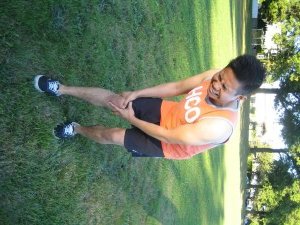Patellofemoral pain syndrome or runner’s knee is a condition characterized by pain at the front part of the knee and the area surrounding the kneecap.
Symptoms
The symptoms of patellofemoral pain syndrome include aching pain in the knee joint, especially at the front area of the knee around and below the patella. Take note that there is often tenderness along the interior perimeter of the kneecap and swelling can oftentimes occur after the individual engages in exercise. Patellofemoral pain syndrome is often worse when the individual walks up and down hills or when sitting for extended periods.
The other signs that the doctor will find include a cracking or clicking sound when the knee is bent, wasting of the quadriceps muscles if the injury was an old one and tightened muscles around the knee joint.
Close look on patellofemoral pain syndrome

It is important to note that pain is common among those who engage in a lot of sport as well as adolescent girls. The condition can have various causes and is often thought that incorrect tracking of the patella over the femur bone can result to damage or irritation of the articular cartilage is a significant factor.
Once damage occurred to the cartilage itself, it could not directly cause pain since there are no blood vessels or nerves. Nevertheless, it can lead to other issues that can also cause pain. These conditions include synovitis which is swelling of the synovial membrane or lining in the knee joint, leading to the wearing away of the bone and cartilage or soft tissue injury or irritation.
The main reason why patellofemoral pain syndrome develops is usually due to overuse or forceful impact on the joint. This can be caused by external factors such as an abrupt increase in the intensity of training or engaging in high impact jumping and bending of the knee. In addition, it can be from internal factors such as poor patella tracking. Remember that the identification of the cause is vital for the treatment.
Treatment
The treatment and rehabilitation is usually based on minimizing the pain, identifying the causes as well as strengthening the muscles that contributed to the injury.
You can utilize the RICE method (rest, ice, compression, elevation) after activity to help minimize the pain and swelling. The individual should rest completely from aggravating activities until there is no pain anymore. If you want to learn how to effectively provide the RICE method, enroll in a first aid and CPR course (Read here for more information about the classes offered).
A patella tracking brace or support is beneficial. These are usually built with a hole in the center for the kneecap along with straps that are pulled across the knee to apply support to the patella. There are also patellofemoral taping techniques that reduce the pain by altering the patellar tracking.
The doctor can confirm a diagnosis and rule out other possible conditions which have similar symptoms such a synovial plica. In most cases, the doctor will prescribe anti-inflammatory medications such as ibuprofen. Just remember though that this medication should not be used by those who have asthma.
Sports massage can also loosen up tight structures and muscles that might be contributing factors. In most cases, gait analysis can also be carried out in order to determine if the individual over pronates and orthotic inserts can help correct the tight lateral structures of the knee but there is not enough evidence to the success of the surgery.
